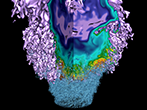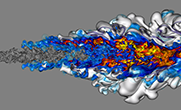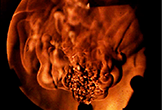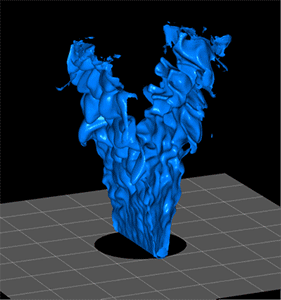CCSE Combustion Team
|
CCSE Staff |
Active Collaborators |
Research
We are actively developing the Pele suite of software for low Mach and compressible reacting flows. The Pele codes are open-source, and available at GitHib for free download. We also conduct research in a number of areas of combustion science, most often with external collaborators, and are always looking to expand this list into new areas. Please contact Marc Day if you'd like to explore new opportunities. Below, is a sampling of the projects under active development using the Pele software.

Pele Suite DevelopmentThe Pele suite is supported by the Exascale Computing Project. The CCSE Combustion Team is focused primarily on the low Mach code, PeleLM, and associated analysis tools. |
|

Compressible and low Mach Premixed FlamesLaminar and turbulent premixed flames in idealized and laboratory-relevant configurations, focusing on the interaction of turbulence and combustion chemistry and the impact of Lewis number. |
|

Turbulent Diffusion FlamesTurbulent diffusion flames have many practical applications. Our work is focused on the jet, and multi-pulsed burning of diesel fuel surrogates. |
|

Multi-brachial FlamesTriple-flames, and penta-brachial flames are idealizations of the flame stabilizations in more complex scenarios, and exhibit many features of the local balances of chemistry, flow straining and species diffusion in an environment much more ammenable to analysis. |
|

Electric-field Assisted CombustionFlames naturally produce a small amount of charged species, and these can be manipulated externally by applying electric fields across the reaction zone. There are a range of interesting, and potentially practical applications of this phenomena. |
|

Uncertainty Quantification, Model Fitting, Parameter EstimationModeling plays a key role in combustion simulations: from inputs specification to the simulation procedure and analysis of the results. MCMC, particle filters and black-box optimization are used explore and build reduced, low-dimensional models of complex reacting flow systems. |
|

Discretizations and Multiphysics CouplingDetailed effects of various discretization approaches on computed turbulent spectra; approaches to couple physical processes that exhibit a wide range of temporal and spatial scales. |
|

Wildfires and Pool FiresSimulating fire at much larger scales introduces an entirely new set of complications. These flames exhibit large-scale pulsing and vortical patterns and complex propagation. |
|

Machine learning in Combustion Simulation and AnalysisMachine learning approaches can be useful for constructing reduced order models of complex systems. |

